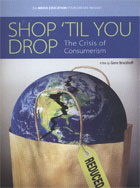
Shop ‘Til You Drop: The Crisis of Consumerism 2010
Distributed by Media Education Foundation, 60 Masonic St., Northampton, MA 01060; 800-897-0089
Produced by Gene Brockhoff
Directed by Gene Brockhoff
DVD , color, 52 min. (Education Version-reviewed); 82 min. uncut (not reviewed)
Sr. High - Adult
Environmental Studies, Ethics, Popular culture, Economics, Business
Date Entered: 09/20/2010
Reviewed by Janis Tyhurst, Reference Librarian, George Fox UniversityThis documentary packs an enormous amount of information in 52 minutes. It concisely targets the issues, both the obvious and the underlying ones, of the consequences of a consumer society. Classes in marketing, sociology, addiction psychology, energy studies and environmental studies can all learn about the connection between consumerism and those disciplines. There is a definite bias against over consumption with only experts advocating a simpler lifestyle being interviewed.
The issues include the economic, social and environmental costs of consumerism. Specific topics include the breakdown of communities and families, feelings of anxiety and alienation, the power of advertising/marketing on influencing societal values and targeted markets like children, global inequities and the unraveling of the environment.
The first half of the film looks at the social effects and the power of advertising on overconsumption. To set the stage and make this film personally relevant, it starts with a recitation by Juliet Schor reading from her book, the The Overspent American: Upscaling, Downshifting and the New Consumer, of the typical American household contents. Schor reads rapidly but it still takes several minutes to list the contents of a typical household. From there we are led into a history of consumption in the United States, starting back in the 1890s. Prior to the 1950s, people in society were defined by the work that they did and the community they lived in. But the industrial age transformed society and values by allowing access to products that had not been available. Conspicuous consumption was a sign of success and in small communities, it was a status symbol to be the first with a new product. With the advent of TVs and attached garages, it was no longer necessary to talk to neighbors and people started defining themselves not by the work that they did but by the things that they owned. Advertising started becoming more sophisticated (“Buy this and you will be popular”), but when neighbors still knew each other, it was the “keeping up with the Joneses” that created demand for products.
With the introduction of women into the workforce, women were exposed to the trappings of a higher economic level and conspicuous wealth became the standard of social status comparison. Advertising changed to target inner wants (“Buy this and you will be happy”). One sign of over consumption, the high that people get when they buy something, is explored in terms of an addiction. The addiction needs to be fed so people buy more than what they need or can afford, and they become anxious and overworked trying to pay for it all. Another sign of a consumer society is that it emphasizes the individual and disrupts community. If we can have it all by our own efforts, then we don’t need anyone else. Loss of community leads to alienation and unhappiness and a willing audience for the marketing mantra of “Buy this and you will be happy.”
The power and influence of advertising is thoroughly explored. Marketers heavily target children, spending 20X more to advertise to that age group, pitching not just a product but an attitude to life. Studies show that children who have less exposure to marketing have a healthier outlook on life. Marketing controls society by controlling the stories being told, and products now have stories that create branding and a connection to the product through these brands. Clotilde Rapaille, though not mentioned in this film, explains in his book The Culture Code how this marketing principle can be used to evoke an emotional response to successfully sell a product.
The second half of the film looks at the economic and environmental costs of consumerism. The focus is on oil, a once cheap source of energy, and how it transformed industry. However, cheap energy is not keeping up with the pace in global growth, and the resulting byproducts are unraveling the biosphere. Petroleum products are in everything from agriculture to plastics. There is also the problem of trash. As humans, we tend to focus on our individual trash output, our gasoline use, and our water use. Individually, we don’t use that much, but when the waste or consumption is taken in the aggregate, the picture that emerges is appalling. Between the need for raw materials to create products to sell and the throwaway mentality of these products when it is easier to buy another rather than repair or recycle, the impact of over consumption on the environment is huge.
Shop 'Til You Drop provides a complete and compelling look at all the issues engendered by overconsumption. Even with a definite bias, it raises questions that need to be thoughtfully considered since the rest of the world is attempting to emulate the lifestyle that Americans have had for the last century.